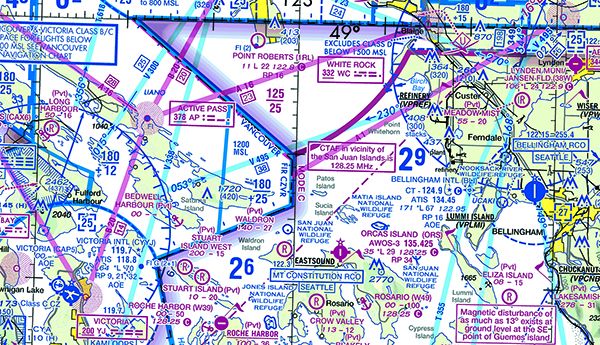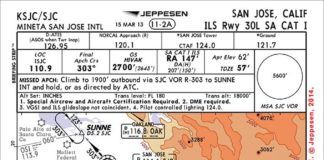Gimme More Pain
I’ve always enjoyed your magazine. Lately, however, it seems that your articles are less rigorous. Perhaps less challenging is a better choice of words. I prefer your sim challenges to be near impossible, your quizzes to be near impenetrable, your weather articles to be arcane. I learn more that way.
Larry Marquez, Collierville, Tennessee
You’re going to love the Sim Challenge in this issue, then, Larry.
Actually, this is a classic case of not being able to please all the people all the time. We’ve gotten some pushback that our material is too difficult at times.
The truth is that there is an ebb and flow to the level of difficulty, based on who the author is and what the particular subject matter is.
Thanks for the feedback; we will definitely keep it in mind.

Geography Lessons
In December’s Chart Clinic article, “The Far Northwest,” Luca Bencini-Tibo states that “Bellingham, Washington, is the northernmost city in the contiguous United States near the Canadian border.” I understand the article was really about being aware of environmental subtleties that can bite you during an instrument approach. But Bellingham isn’t even the northernmost city in Washington State, let alone the entire Lower 48. (Just ask the proud folks in Lynden, Washington.)
The same can be said for airports: Bellingham International (KBLI), at latitude N48.47.56, is obviously far from being the northernmost airport in the Lower 48. It’s also not the only one where penetration of Canadian airspace is required to shoot an approach.
Minnesota’s Piney Pinecreek Border airport (48Y), among others, has KBLI beat, sitting at a border-straddling N48.59.94; and their RNAV (GPS) RWY 15 approach, except for the missed approach, is flown entirely inside Canadian airspace.
“Good day, eh.”
Tom Curran, Gig Harbor, Washington
(way south of Bellingham)
We’re sending Luca back for a grade-school geography refresher. Thanks for the note, Tom.
Regarding the Chart Clinic, “The Far Northwest” by Luca Bencini-Tibo, Victoria Island is in the arctic.
I once had to explain to an Alaska Airlines crew that Victoria is merely a city on the south end of Vancouver Island (and that the city of Vancouver isn’t on Vancouver Island). They said it didn’t matter as long as they knew how to get where they were going but I wasn’t convinced.
I grew up near Vancouver so I was a little surprised to learn it’s a fairly common point of confusion for non-locals.
Iain Clark, San Jose, California
Not All Are Created Equal
As a DPE, I must correct Fred Simonds’ reference in “The Honorable Pilot” in your October issue, to the “school of thought” that asserts examiners make up their minds about applicants in the first 30 seconds. Speaking for myself and the examiners I know, nothing could be further from the truth. Instead, I make up my mind after the last task is completed successfully—or when the first one is unsatisfactory. Because everyone is nervous at a checkride, it would be irrational and contrary to regulations and orders to come to an early conclusion based on an applicant’s demeanor, voice, or any other affect.
What DPEs want is simple: that the applicant be ready to perform all the tasks according to the ACS and within the stated tolerances. Concerns about other factors or what the examiner “wants” are just a waste of time and stressors in their own right.
David Abrahamson, Location withheld
We forwarded your note to Fred and he replied:
I stand by what I wrote, and here’s why.
I made a broad statement that there is a school of thought that asserts what I said, and there is. My Chief Pilot at my last flight school, who had taken more FSDO checkrides and held more paper than any pilot I’ve ever known, was the source of this remark. He wasn’t the only pilot who felt this way.
Years ago, when I took my CFII ride the oral was several hours until I caught the examiner on an error, at which point the oral ended abruptly. Hmm.
On the practical, I never touched the controls or spoke a word. Byron spent 45 minutes teaching me how the magnetic compass precessed and dipped. On the way back to the airport, he informed me he would write me a license. It seems he had made up his mind well before the engine started.
I made no judgment as to whether first impressions are appropriate or even if the practice is widespread. I respect Mr. Abrahamson’s approach. It’s fair, logical, and objective—exactly what we’d hope. Unfortunately, it’s not universal.
I have met and been forced (by flight schools) to send applicants to assorted examiners who we personally observed would consistently fail female, Asian, Indian, Hispanic, and Black applicants. Some examiners served in Vietnam and clearly nursed long-standing dislikes (to put it mildly) of Asians.
Fellow instructors complained privately about examiners who failed applicants on tasks outside the scope of the PTS or ACS or could not answer an arbitrary question. One sticks in my memory: “What’s the best way to check a VOR?” Huh? This outstanding applicant failed the CFII oral on that very question. He completely gave up on his CFI after that.
One examiner was a former police officer. With him, no cop failed a check ride. One furious officer passed an instrument check ride he considered the worst performance of his life.
So, although I’d hope that all examiners have the integrity and open-mindedness of Mr. Abrahamson, my experiences suggest differently. Worse, to my knowledge, there is no recourse to the FSDO to identify bad-apple DPEs. Even if there is, the applicant is sure to lose.
Bottom line, David, is it seems that, like pilots, some examiners are better than others. Thanks for being one of the good ones.
Liked RTC Training
I was happy to find RTC for my recurrent training. I fly a Cessna 340A with a panel setup very nearly that of the RTC simulator. Major differences are the GNS 430s vs. my twin GNS 530Ws and the position of the breakers.
All in all I find that I get a real workout in emergency procedure practice in a variety of conditions. Even though the autopilot of the RTC simulator is a bit different from my IFCS 800, my training experience in the simulator is that RTC’s autopilot is not very reliable and it fails often requiring a large amount of hand flying—which is probably good for training.
My workout at RTC instills a huge amount of confidence in my abilities. When I come home I feel ready to tackle most anything my airplane offers.
Jabe Luttrell, Key West, Florida
Please don’t misunderstand. I found RTC training to be good. My comments were focused on the simulator and I pointed out that this was an indictment of limitations the FAA places on sims.
You are lucky that the RTC sim closely resembles your aircraft for a good translation to your real-world flying. But know that certified sims can’t be updated as easily as our aircraft.





